

|
| ČESKÁ REPUBLIKA | CZECH REPUBLIC |
| Jihočeský kraj | South Bohemia (České Budějovice) region |
| Okres: České Budějovice |
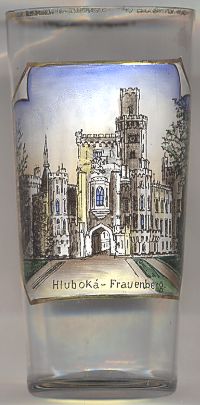 Hluboká nad Vltavou is situated at an alitude of 394 m on the river Vltava (German: Moldau) in southern Bohemia, about 10 km north of
České Budějovice. The municipality has a population of about 4,700 (2005).
Hluboká nad Vltavou is situated at an alitude of 394 m on the river Vltava (German: Moldau) in southern Bohemia, about 10 km north of
České Budějovice. The municipality has a population of about 4,700 (2005).
The area had already been inhabited in the early Bronze age. Two strongholds were founded in the early 1st century on hills in the vicinity of Hluboká. Slavic settlers came into the area in the 7th century. The castle Froburg (later German name Frauenberg) was later founded on an elevated site above the river Vltava. The Czech name Hluboká was first mentioned in the 14th century. In 1908 the village obtained the status of a town. Until 1912 the official Czech name was Podhradí pod Hlubokou.
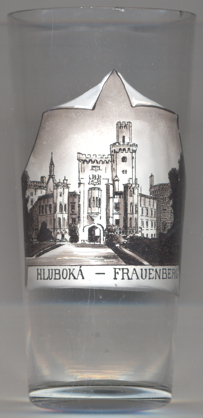
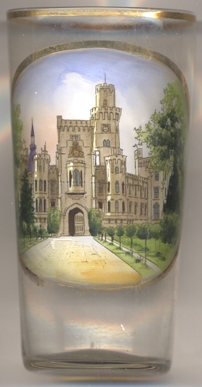 The original
The original  Hluboká castle [left] of King Otakar II Přemysl dated from the second half of the
13th century. After his death it came in possession of the Vítkovci (German: Witigonen) dynasty but later returned again to the Bohemian Crown.
When the castle was obtained by the lords of Pernštejn a flourishing period for the castle and the nearby village
began. In 1562 the castle was sold by Emperor Ferdinand II to the lords of Hradec who ordered Baldassare Maggi to rebuild
the castle in Renaissance style. In 1661 the castle was obtained by the Schwarzenberg dynasty. During the Thirty Years' War (1618–1648) the castle
was occupied by French troops and during the siege by Austrian troops the lower castle was destroyed. After that the fortifications were torn down by the
Schwarzenbergs so that the castle would not be a target of military actions. In the early 18th century, the architects Paul Ignaz Bayer and his successor
Anton Erhard Martinelli rebuilt the castle in Baroque style. In 1799–1800 the castle again served as a headquarters for the Russian troops during
the Napoleonic wars. In the second third of the 19th century the castle was rebuilt in splendid Tudor Gothic revival style
by Johann Adolf II of Schwarzenberg. The designs were made by the Vienna architect Franz Beer who supervised the
buidling works from 1840 until about 1460. The intricate exterior and interior decorations were finally finished by Ferdinand Deworetzky in 1871.
Hluboká castle [left] of King Otakar II Přemysl dated from the second half of the
13th century. After his death it came in possession of the Vítkovci (German: Witigonen) dynasty but later returned again to the Bohemian Crown.
When the castle was obtained by the lords of Pernštejn a flourishing period for the castle and the nearby village
began. In 1562 the castle was sold by Emperor Ferdinand II to the lords of Hradec who ordered Baldassare Maggi to rebuild
the castle in Renaissance style. In 1661 the castle was obtained by the Schwarzenberg dynasty. During the Thirty Years' War (1618–1648) the castle
was occupied by French troops and during the siege by Austrian troops the lower castle was destroyed. After that the fortifications were torn down by the
Schwarzenbergs so that the castle would not be a target of military actions. In the early 18th century, the architects Paul Ignaz Bayer and his successor
Anton Erhard Martinelli rebuilt the castle in Baroque style. In 1799–1800 the castle again served as a headquarters for the Russian troops during
the Napoleonic wars. In the second third of the 19th century the castle was rebuilt in splendid Tudor Gothic revival style
by Johann Adolf II of Schwarzenberg. The designs were made by the Vienna architect Franz Beer who supervised the
buidling works from 1840 until about 1460. The intricate exterior and interior decorations were finally finished by Ferdinand Deworetzky in 1871.
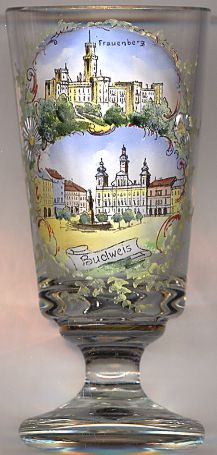
The bottom pictures on glass no. 2574 [left] and no. 4868 [below] show a view of
České Budějovice.
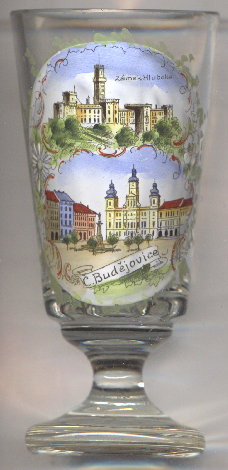
Note: the two glasses on the left are decorated with identical pictures (individually coloured by hand), but they differ in the language of the labelling:
glass no. 2574 [far left] is labelled in German: Frauenberg and Budweis, while
glass no. 4868 [near left] is labelled in Czech: zámek Hluboká (Hluboká castle) and
Č[eské] Budéjovice.
![[scale]](lineal.jpg)